Are you feeling like your Google Ads campaigns are stuck in a rut and not giving you the results you want? Well, it’s time to roll up your sleeves and get to work. In this post (that we’ll always keep updated in the future), we’re diving deep into the nitty-gritty of conducting a Google Ads audit for your business.
We’ll be covering the specific steps you need to take to review and improve your account structure, targeting, ad copy and creative, keywords and quality score, and campaign performance. But don’t worry, we’ll surely add a healthy dose of humor to keep things light and fun. And, we’ll also be sharing some common mistakes business owners make in Google Ads and how to avoid them, so you don’t have to pull your hair out (or your charging cable).
So, whether you’re a tech-savvy business owner or just a beginner, this guide is for you. Because, let’s be honest, no one wants to be the butt of the tech joke in the business world. So, let’s get ready to give your Google Ads campaigns the makeover they deserve!
Jump To:
Step 1: Understand your advertising goals
Step 2: Review performance trends
Step 3: Review Your Account Organization
Step 6: Dig deeper into your Ads
Step 7: Additional items to review
Why a Google Ads audit is like a personal trainer for your campaigns
How to Conduct Audits Regularly
Tools that can help you in conducting the audit
[Bonus] Common Mistakes Business Owners Make in Google Ads
The Audit Process
Let’s face it, the thought of conducting a Google Ads audit can be daunting. It’s like trying to fix a leaky faucet, you know it needs to be done but you’re not quite sure where to start. But don’t worry, we’ve got you covered.
First things first, before diving into the nitty-gritty, it’s essential to have a clear understanding of what a Google Ads audit is and what it entails. A Google Ads audit is a comprehensive review of your account, campaigns, and ad groups to identify areas for improvement and opportunities to optimize your performance. Think of it like a check-up for your campaigns, you want to make sure they’re running at their best and not wasting your money.
Now, let’s get down to business. To conduct a Google Ads audit, you’ll want to understand your advertising goals & performance trends first and then focus on areas like account organization, basic setups, metrics, and ads. We’ll be going over each of these areas in more detail later on, but for now, just know that these are the areas you’ll want to focus on.
And, don’t worry if it all sounds a little overwhelming. Just remember, a Google Ads audit is like a puzzle, and each piece plays an important role in the bigger picture. So, let’s get started and put the pieces together!
Step 1: Understand your advertising goals
Always start with vivid understanding of what success looks like for you (or your client) in terms of advertising. Be clear on your advertising goals. Are you advertising to increase brand awareness? increase visits to your website? or to drive more sales? Having well defined advertising goals help you to achieve desired results quickly and efficiently.
Additionally, don’t focus on goals that don’t bring value to your business. For e.g. if a low CPC (cost per click) goal isn’t bringing you more conversions, then why chase it?
Step 2: Review Performance Trends
Before diving head-first into the technical details, you should review your performance trends. How has the account performance changed and over what time period?
For this review, don’t choose a small date range (a few days or a couple of weeks) because there won’t be enough data from which you can extract meaningful conclusions.
On the other hand, choosing a fairly long time period (3 months plus) will also not yield important insights as there will be too many variables affecting the account & campaign performance.
Usually, the best time period to look for performance trends is from 30-60 days. Look for the way the advertising performance has been trending over this period and compare it with current performance.
If any areas have performance issues that persist beyond 30 days, then those areas need to be investigated in more detail. Alternatively, if your performance is on a steady decline (or incline) you can identify when this started and work towards finding a probable cause.

Step 3: Review Your Account Organization
Like a house needs a strong foundation, your Google Ads account needs a solid structure. And, like a leaky foundation can cause problems, a poorly structured account can lead to wasted ad spending and subpar performance.
A proper account structure ensures that your campaigns are organized and easy to navigate. This makes it easier for you to identify and fix any issues and ultimately leads to better performance. A well-defined account structure helps you identify where your conversions are coming from. By understanding which campaigns and ad groups are driving the most conversions, you can optimize your spending and focus on the areas that are working best. It also helps you to exclude irrelevant traffic to your campaigns and ad groups. By using negative keywords and targeting options, you can ensure that you’re only reaching the audience that is most likely to convert. While reviewing your account structure, have a look at following:
Campaigns and Ad Groups
Make sure your campaigns and ad groups are organized logically. This means that campaigns and ad groups should be structured according to themes of the keywords, locations, services, or goals. For example, if you’re a clothing store, your campaigns should be organized by clothing type (e.g., men’s clothing, women’s clothing, etc.). If you offer your products or services to customers in multiple locations, you could define separate campaigns targeting each location independently.
An important note to remember, budgets are controlled at campaign level. You should segment your campaigns on how you want to control your budget to get max performance. Here are a few examples highlighting the benefits of campaign segmentation:
- You can create a low-budget experimental campaign while keeping the budget of your core campaigns constant.
- Well-performing keywords could be spun out into their own dedicated campaign so that more budget could be assigned to them.
- If you are a service provider, you can set up multiple campaigns, each dedicated to a specific service, and then assign more budget to services that are more important for your business.
Intent Based Ad Groups (IBAGs)
A recent strategy to effective campaign organization is to use Intent-based Ad groups (IBAGs). There was a time when Single Keyword Ad Groups (SKAGs) were a popular choice to ensure high keyword to ad relevance, but due to various changes google has introduced to its keyword match types, SKAGs have become less effective and messier to manage.
While SKAGs provide the tightest control over keyword to ad relationship (one keyword per ad group), IBAGs provide somewhat looser control than SKAGs. The main difference between SKAGs and IBAGs is the shift of focus from keywords to intent.
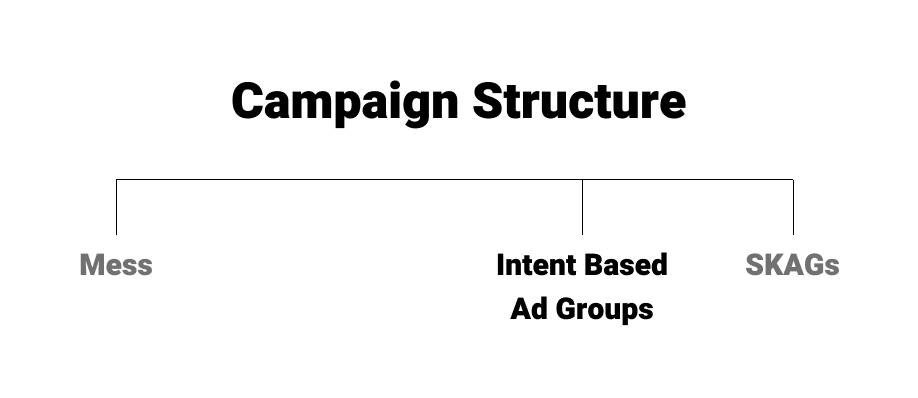
Instead of focusing strictly on keywords, we design loose ad groups that group keywords with the same intent in the same ad group. Interpreting a searcher’s intent means that our ads address what a searcher is trying to achieve.
For e.g. someone searching for “smart tv price” or “smart TVs cost” is price-conscious. And our ads need to have an answer to that.
That means we cannot just focus solely on the number of clicks in the search terms report, we’ll need to actually comprehend what a person is searching for and whether or not that intent is already addressed in our ad structure.
If you have stuffed multiple keywords representing different intents in a single ad group or you’re using SKAGs, you need to revise your setup using Intent-based Ad Groups (IBAGs) by grouping same-intent keywords in ad groups. This will help you in handling the impact of Google’s keyword match type updates while allowing you to exercise better control over your ad groups.
Geography
Review the geographic locations you are targeting and make sure they align with your business goals. For example, if you’re a local business, you’ll want to target people within your state, city, or maybe your local neighborhood only. If you’re a national business, you’ll want to target people all across the country.
Do not target multiple countries in a single campaign as it will restrict your ability to optimize budgets, language, culture, and other location-specific variables in your campaigns. Check for any discrepancies in your geographic targeting and make adjustments where necessary.

A recommended approach to location targeting is if you want to target a country, instead of targeting the whole country as a single location, break your targeting into separate sub-locations such as provinces, states, or cities. This will help you in optimizations down the road as you can then adjust your bids for specific locations depending on how well they’re performing.
Networks
Google offers multiple networks where you can show your ads, for e.g. google search, search partners, display network etc. The best way to utilize your budget effectively is to target a single network per campaign.
If you target multiple networks in a single campaign, like running search with display added for example, lets your ads roam free over display network resulting in wasted ad spend.
Another important consideration is to understand which funnel level are you targeting. If you are targeting Top of the Funnel (TOFU) or Middle of the Funnel (MOFU) traffic which is generally low-intent, then display network will give you more results, but if you’re targeting Bottom of the Funnel (BOFU) traffic, then search network is your best bet. So choose wisely.
Doing something as trivial as removing display networks & search partners from your search campaign’s targeting could help in improving its budget utilization & performance by leaps & bounds.

Number of Ads per Ad Group
If you only have a single ad in your ad group, you’re not testing ads which is a big no no. Since Expanded Test Ads (ETA) were retired back in June 2022, you should have at least 2 Responsive Search Ads (RSA) per Ad group. The maximum number of RSAs that you can have per ad group is 3. For maximum efficiency, both ads should be radically different from each other so that you can perform A/B testing using different headlines, descriptions and extensions.
Analytics Linking
Your Google Ads account should be linked to your Google Analytics account so that you can perform deeper analysis of the data being generated from your campaigns. It also allows you to view additional metrics like bounce rate associated with your Google Ads Campaign landing pages. When you’re doing PPC campaigns across multiple channels, you’ll also need Google Analytics to understand cross-channel attributions.
you can find Google Analytics settings under Tools and Settings > Measurement > Google Analytics in top menu.
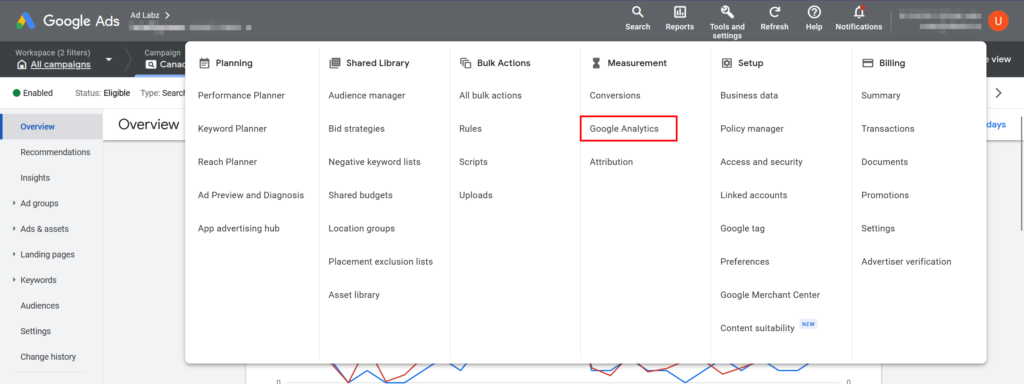
Conversion Tracking
Make sure you have conversion tracking set up so you can see where your leads and sales are coming from. Conversion tracking allows you to see which campaigns and ad groups are driving the most conversions. Additionally, make sure that you are tracking all the important conversions like website purchases, phone calls, and form submissions. This will help you understand which areas of your account are working best and which need improvement.
If you don’t validate your conversion tracking settings during the audit, your account data will become useless and your budget may be wasted. Most businesses have conversion settings setup incorrectly. A study found that only 29% of Google Ads account have accurate conversion tracking setups.
Here are some tips for conversion tracking:
- Use Google Tag Manager (GTM) to set up conversions easily and quickly.
- If you have already set up conversion tracking using GTM, you can utilize the Google Tag Assistant Companion chrome extension to test whether conversion events are firing correctly when someone submits a conversion on your site.
- Another important test is to check your conversion action is firing just once and not multiple times. You can test this using Google Tag Manager’s preview and debug mode.
- Alternatively, you can take help from Google’s conversion tracking setup guide to check if you missed anything or utilize Google’s troubleshooting tool.
Accurate conversion tracking is one of the key steps in ensuring the optimum performance of your Google Ads campaigns. If all else fails, let the Pros do it for you. We’re experts in setting up & troubleshooting conversion tracking.
Campaign URL Settings
While reviewing the campaign settings, ensure auto-tagging is enabled. Auto-tagging adds a parameter to your URLs to help you track offline conversions and report on your ad performance using website tracking programs like Google Analytics. This is particularly useful if you’re in lead gen business as it helps track leads across their life cycle.
Subsequently, you can use tracking template or final URL suffix settings to track additional information about clicks and the leads associated with them using UTM tags.
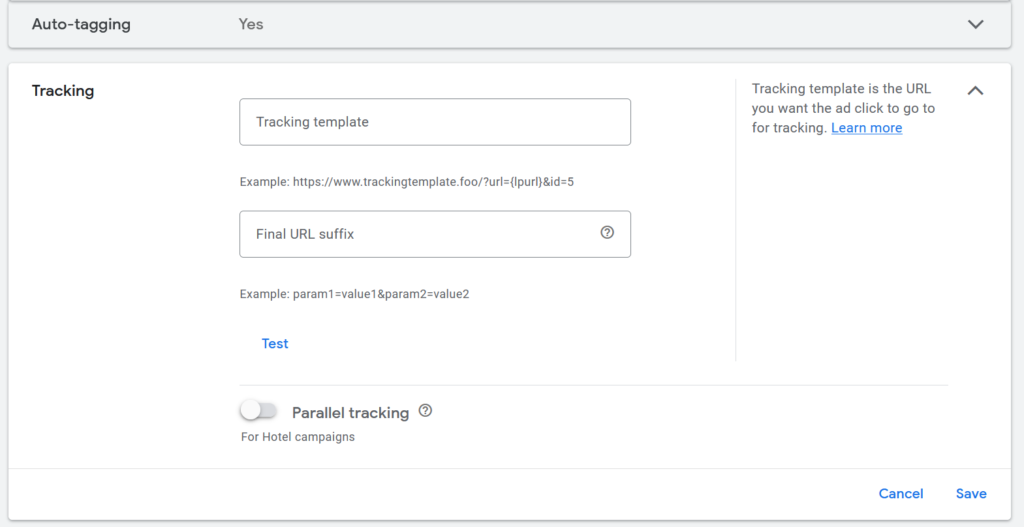
Here is a sample tracking template that could be used to fetch additional information about the click:
{lpurl}?utm_source=google&utm_medium=ppc&utm_campaign={campaignid}&utm_content={adgroupid}&utm_term={keyword}
The tag is associated with the URL when someone clicks the ad and parameters in curly braces are populated about the information about the click. UTM tags could be applied at the account, campaign, ad group, or ad level, however, we recommend applying them on the account level.
Step 4: Analyze the basics
Like a first impression can make or break a relationship, your ad copy and creative can make or break your Google Ads campaign. A bad ad copy and creative can lead to wasted ad spend and poor performance.
Analyzing your ad copy and creative is crucial to ensure that it aligns with your business goals and effectively drives conversions. By identifying the areas that are working best, you can optimize your spending and focus on those areas. Additionally, by making sure that your ad copy and creative are clear, concise, and compelling, you can increase the likelihood of people clicking on your ads which in turn will increase your conversion rate.
Keywords & Negative Keywords
Review your keywords to make sure they align with your business goals and are relevant to your products or services. Check for any irrelevant keywords or phrases that might be hurting your performance, duplicated keywords that might be lowering your quality score, and keywords with low search volume or low relevance that might be hurting your performance.
While reviewing, check which keywords are getting clicks and spending budget but not converting, if a keyword is spending budget but not converting for the past 30 days, then it means that there is something wrong.
An important consideration is keyword match type. If you are tight on budget, avoid broad match type as much as possible, because it has a high chance of triggering your ads against non-relevant search terms.
Make sure to review the search terms report which shows you which search terms triggered your ads. It will give you insights about what users are actually typing into the search box that is triggering your ads. If you see searches that are not relevant to your product or service, ad those to your negative keywords to prevent them from triggering your ads again.
Make sure you are using negative keywords to exclude irrelevant traffic. Negative keywords are words or phrases that you don’t want your ads to show up for. For example, if you’re a clothing store, you would want to use negative keywords like “free” or “cheap” to exclude people who are looking for free or cheap clothing. Furthermore, ensure that you are using broad match, phrase match, and exact match types for your negative keywords. This will help you to exclude irrelevant traffic more effectively.
By default, Google will add every negative term as an exact match, so if there is a term that is completely irrelevant to your product or service, add it as a phrase match or broad match in negative keywords. for e.g. if you’re selling software development services and your ads are being triggered by terms like “software developer resume”, then better add “resume” as a phrase match or broad match negative keyword to completely exclude it. You can also make use of Negative Keyword Lists to exclude terms across multiple campaigns.
Remarketing
Your campaigns can never have 100% conversion rate, so once your campaigns have sufficient conversion data available, you can make use of remarketing campaigns to recapture visitors who clicked but didn’t convert. Otherwise lots of additional opportunities are lost. You can utilize both search and display networks for remarketing to customers who previously clicked on your ads and visited your landing page but did not took a conversion action.
Bids and bid strategy
Google offers multiple types of bidding strategies including manual, semi-automated and fully automated bidding strategies. If you’re setting up a new campaign, it is recommended to start with manual bidding. Once you have sufficient conversion data available, then you can switch to either Enhanced CPC (ECPC) which is semi-automated or a fully automated strategy like Taget CPA, Target ROAS or maximize conversions. Remember, Google needs sufficient data in account to fully optimize its machine learning algorithms so switch to semi-automated or fully-automated strategies only when sufficient conversions data is available in your account (10 – 20 conversions at least).
Bid adjustments
If you’re not taking advantage of bid adjustment features provided by Google Ads then you’re missing on results. Bid adjustments allow you to increase or decrease your bid amounts by a certain percentage depending on factors such as location, devices, audience demographics and time of the day etc.
You notice that your ads are performing better in Texas than in Utah? increase bids for Texas by 10%. Your customers are converting better on Mobile? Increase bids for mobile devices by 20% and decrease them by 10% for other devices.
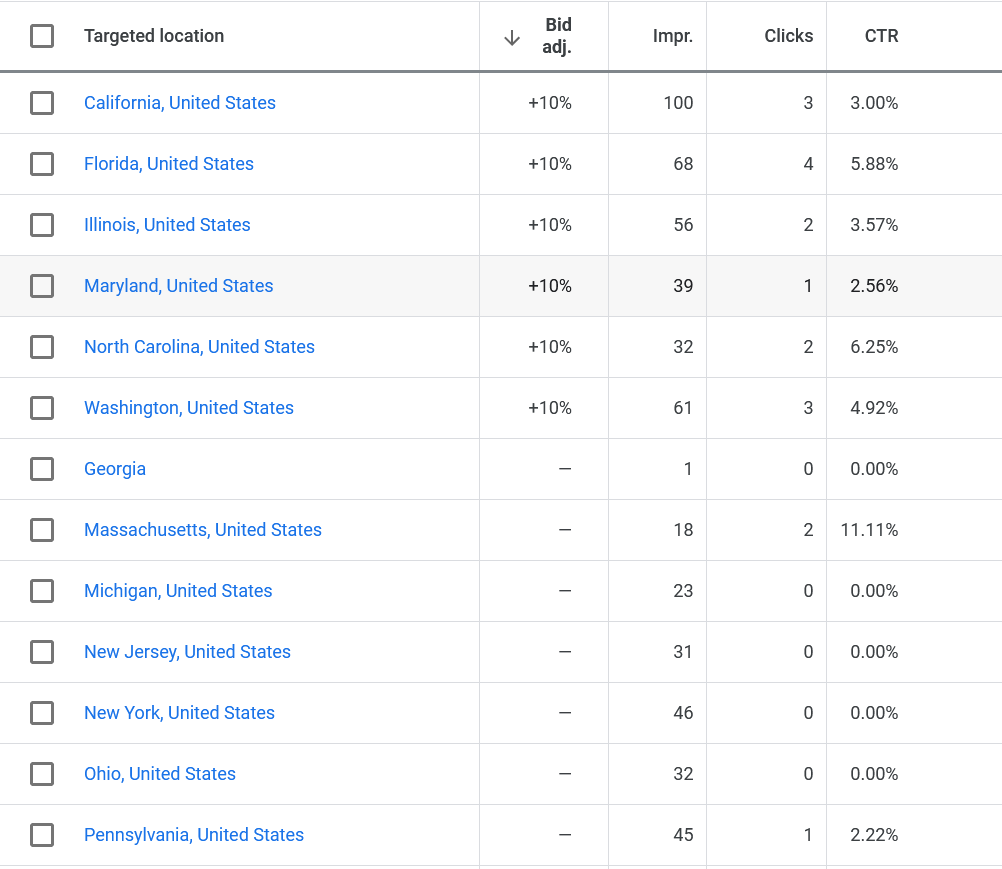
Bid adjustments are your secret weapon in maximizing performance, so if you’re not using them already, start doing so.
Targeting Settings
During your Google Ads Audit, it is important to make sure you’re targeting the right people in the right places with your ads, so you need to review your location targeting in detail.
Locations
Make sure you’re targeting the right countries, states, cities or localities (if you’re hyper local) where you should run your campaigns. Never target all countries & territories (even if you operate on a global scale). It is always better to segment your target locations into smaller sub locations and then target those locations, this will help you in bid adjustment later on. For e.g. if you’re targeting United States, do not select whole United States (country) as location, instead target all US states individually so that you can make state-wise bid adjustments based on performance.
Location Options
Dig into your campaign’s location options. If you want to target only the people within your targeted locations, select “Presence: people in or regularly in your targeted locations.” you can select other options if you also want to target people who are interested in or searching for your target locations. These options are helpful if you’re selling services to people foreign to your target locations (for e.g. travellers). Location options could be accessed by going into Campaign Settings > Locations.
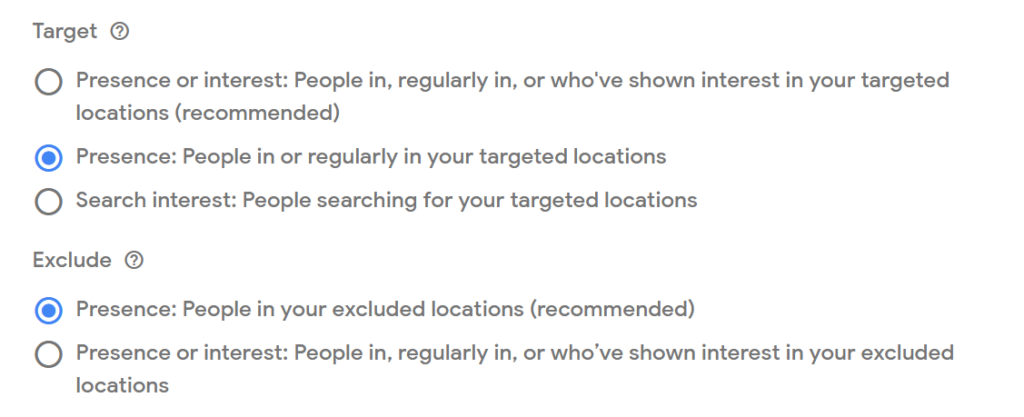
Languages
Your campaign should target the languages your audience speaks (and the language you have created your ads in). Language settings could be accessed by going to Campaign Settings > Languages.

Ad Schedules
Review whether your ads are being shown at the right days of the week and also at the right times of the day. For businesses targeting other businesses, you may want to show your ads only during office hours but for businesses who are able to respond to customers 24/7 may choose to run their ads all the time. Also check which days of the week and times of the day are performing better than other days & times, then use bid adjustment feature to increase bids for those days and times.
Budgets
The campaigns performing the best should get the larger share of your budget, while the ones that are behind in performance should be optimized or completely shut down. There is no benefit in barely keeping the lights on in low-performance campaigns.
Landing Pages in Use
Your landing pages are a key element in customer’s journey to conversion, so if your landing pages are not properly designed or optimized, your ad spend will go to waste. Here are a few tips on landing pages:
- Landing pages should be hyper-relevant to your ads. If your ad is talking about sneakers on sale, then your landing page should not present visitors with watches for sale. Google will penalize you if your landing page experience is below average.
- Keep only one strong CTA on your landing page, which is essentially your conversion action. This will help visitors maintain focus. Adding too many CTAs on the landing page will allow visitors to be distracted easily and wander off to someplace else that you don’t want them to.
- Ensure your website is mobile-friendly because a lot of search traffic comes from mobile. If your landing page is not optimized for mobile, then you can discourage mobile traffic using negative bid adjustments on device types.
- Provide useful and unique content and be clear on the messaging about the products and services that you offer.
- Make sure your landing page is super easy to navigate and make it quick and easy for visitors to perform the conversion action you want them to take.
Step 5: Analyze Your Metrics
As numbers are the language of business, campaign performance is the language of Google Ads. And, just like numbers can tell you how your business is doing, campaign performance can tell you how your Google Ads campaigns are doing.
Analyzing your campaign performance is crucial in order to identify areas where you can improve and optimize your campaigns. Campaign performance data can provide insights into how your ads are performing, where your conversions are coming from, and how much you’re spending on ads.
Return on Ad Spend (ROAS)
Return of Ad Spend (ROAS) is one of the most important metrics for e-commerce businesses. It informs you how much money you’re making with respective to what you’re spending on your ads. If you’re generating $4 on every $1 spent on ads, you have an ROAS of 4.
to review ROAS, check “conv. value/cost” metric in Google Ads, If this value is 1 or below, then you need to do some work to improve this metric.
Conversion Volume
Similarly, conversion volume is important if you want to ensure maximum number of conversions against your budget. Have a look at number of conversions for the past 30-60 days. If there is a sudden drop (or increase) in conversions, then this needs to be investigated.
If your campaigns are struggling with conversions, are your targeting the right keywords? Is your budget being spent on the right searches? Are your bids winning in the right auctions? if you’re using manual CPC have you tried Enhanced CPC (ECPC)?
Cost Per Acquisition (CPA)
Review your cost per conversion to make sure it aligns with your business goals and is within your budget. Check for any discrepancies in your cost per conversion and make adjustments where necessary. Lower CPA is necessary if you want to maximize conversions within the same budget. If your CPA is high right now, you can check which locations, devices or demographics are proving to be expensive in terms of conversions. Once you identify the culprits, you can increase your bids for devices, locations and demographics having lower cost per acquisiton.
Offer
All of conversion related metrics are highly influenced by your offer. If your offer is not aligned with the intent of the keywords and search terms, conversion volume will be low along with lower ROAS and higher CPA.
Click-Through Rate (CTR)
Review your click-through rate to make sure it is high enough to be competitive and drive conversions. Check for any discrepancies in your click-through rate and make adjustments where necessary. Find out what is the average CTR for your industry then compare it with your average CTR for past 30-60 days. If it is below industry average, then you need to re-visit the connection between your keywords and Ad copy. Low CTRs mean that people are not seeing relevancy in your ads when they see them.
Cost Per Click (CPC)
Your ads will have a higher Cost Per Click if your quality score is low or your ad relevancy with keywords is weaker. So keep an eye on your CPC and if you find it higher than standard CPC rates for your industry, make necessary adjustments in Ad Copy, Max CPC bids and negative keywords to reduce it to an acceptable level.
Impression Share
Review the impression share your ads are getting. If your impression share is less than 50%, it means that your ads are missing from 5 out of 10 searches related to the keywords that you are targeting, and those searches could be the ones that will give you conversions. To increase your conversion share, you’ll have to increase your bids so that you become more competitive in the auction that takes place with every search. Aim for an impression share of 70% or higher to capture significant amount of search traffic.
A recommended way of viewing the impression share report is at keyword level. To view it, visit Keywords section and select one (or multiple keywords) using checkboxes and then select Auction Insights from the blue action bar that appears.
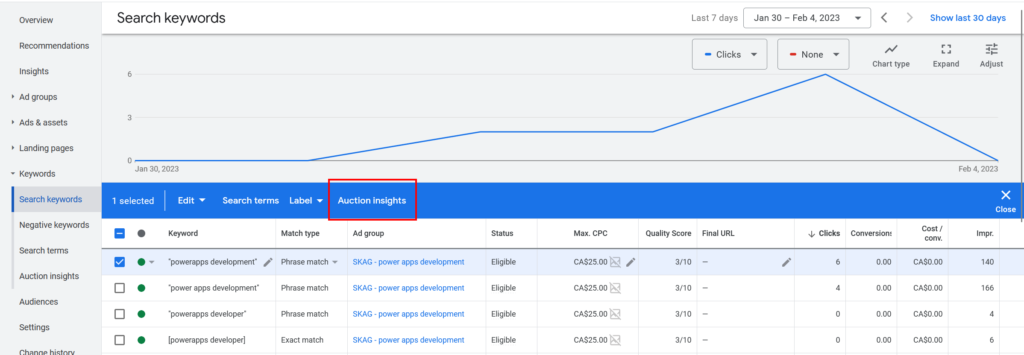
Step 6: Dig deeper into your Ads
Ad Copy
Review your ad copy to make sure it aligns with your business goals. Check for any grammar or spelling errors, inconsistencies, and irrelevant keywords or phrases that might be lowering your ad quality score. A simple but effective check is to gauge the relevancy of your ad copy to the intent of the keywords you are targeting.
Additionally, you should perform A/B testing with your Ads by creating multiple ads with drastically different copy. This will provide useful insights into which phrases and CTAs are performing better than others. Do not try to stuff multiple intents into a single Ad, keep same-intent keywords grouped together in their own Ad groups and match the Ad copy with the intent.
Spelling & Grammar
This is one of the most obvious recommendations, but it often gets missed. Always check the spelling and grammar of your Ads before publishing them. If you have a large number of Ads, download them to a spread sheet tool and perform spelling and grammar check there. Alternatively, you can use a tool like Grammarly to check spelling and grammar on the go.
Ad Extensions
An effective way to improve CTR is to ensure your ads are the biggest ones with the most information and reasons for visitors to click on, this is where ad extensions are life-savers.
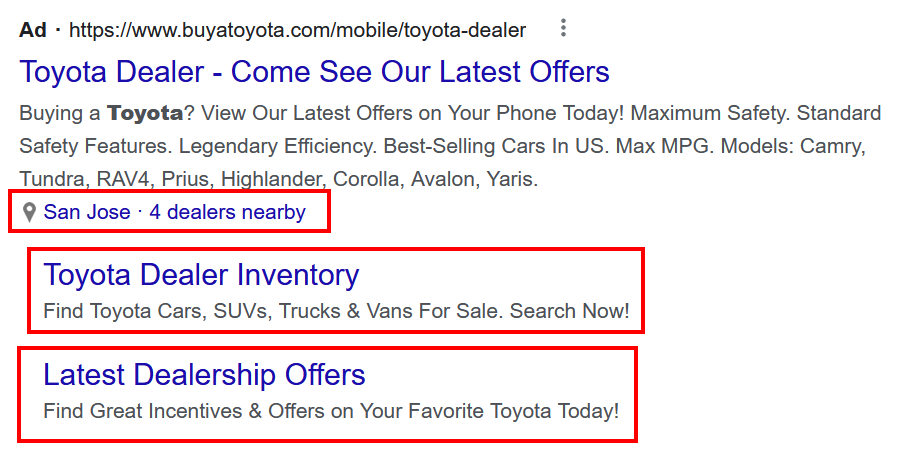
The red boxes in above ad are extensions that are being used to provide more information about the brand or product / service being offered. You should use every single extension that is relevant to your business. That being said, every campaign should use following 3 types of extensions which are universal in nature:
- Site Links: 8 – 10 per campaign. Minimum 2.
- Callouts: 6 – 10 per campaign. Minimum 4.
- Structured Snippets: 4 values per heading. Minimum 2
Ad Rotation
Make sure you have created at-least 2 ads with different variations of copy in each ad group. Also, select “Optimize: Prefer best performing ads” option under Ad Rotation settings for your campaign so that Google Ads automatically prioritizes best performing ads while showing them to visitors. You can find Ad rotation settings by going to Campaign Settings > More Settings > Ad Rotation.

Responsive Search Ads (RSA)
While creating Responsive Search Ads (RSA), ensure you are using your keywords in headlines and descriptions. This becomes somewhat difficult when you’re working on Intent-Based Ad Groups (IBAGs) because each ad group contains multiple different keywords which have the same intent. In such cases, you can use the Google Ads dynamic keyword insertion feature to automatically insert relevant keywords in your headlines and descriptions. Also, to make sure your ad makes sense in all cases where Google randomly combines different headlines together, try pinning certain headlines to specific locations so that the pinned headline always shows at a fixed location everytime.
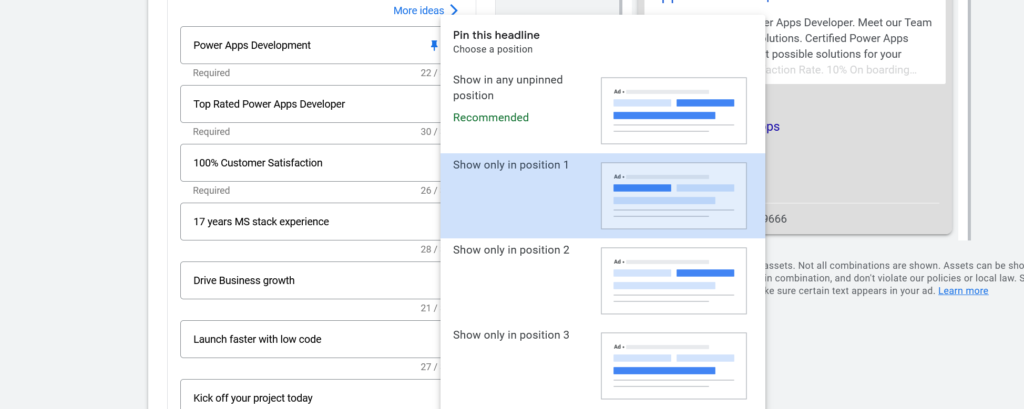
Quick Tip: If you are pinning headlines and Google shows your Ad strength as “average” or “low”, one way to increase Ad strength is to add more pinned headlines at the same location for e.g. pin multiple headlines at position 1, this will help in increasing ad strength to “good” or above. Try different headline and description combos.
Responsive Display Ads (RDAs) or Uploaded Display Ads
For display campaigns, you can use either uploaded display ads or responsive display ads (which automatically generate ads from the assets and ad text you provide). If you’re using uploaded display ads, make sure you have uploaded all the possible ad sizes that Google allows you to. If you don’t do this, you will miss out on some valuable ad placement opportunities.
Generally speaking, RDAs are your best bet to get the maximum juice out of your display campaigns with the least amount of effort. So switch to Responsive Display Ads whenever possible.
Video Ads
Most video campaigns are used to target Top of the Funnel (TOFU) traffic, so you need to verify if your messaging is correct along with the types and length of video ads that are best suited for your goal. Here are some best practices for video ads:
- Engage with users during the first 3-4 seconds.
- Ensure your landing pages are contextually aligned with your ad.
- Your video ads should make sense without sound as most people engage with videos without audio.
- Your CTA should be clear and actionable.
- Make your Ads mobile-friendly as the majority of viewers will engage with them using mobile devices.
By taking the time to check your ad copy and creative, you’ll be able to ensure that your ads are making a great first impression, reaching the right audience and effectively driving conversions.
Step 7: Review additional items
Change History
Change history is an audit log of sorts in the Google Ads interface. If you’re auditing an account managed only by yourself then you can ignore it but if your account is being managed by an agency or employee, then this log could prove very useful.
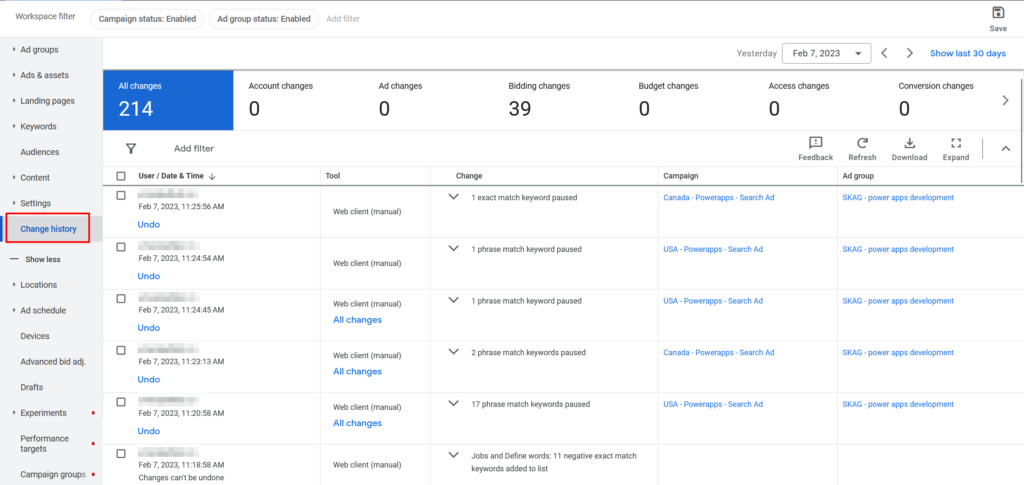
Display Placements
If you’re using audience targeting options other than display placements, you might want to review where your ads are being shown. You can review these placements by visiting the “Where Ads Showed” screen under the Content option in the left menu. While reviewing, you can see on which sites and apps your ads are being shown and how many impressions and clicks you’re getting from them. If there are any sites or apps where you don’t want to show your ads, you can simply exclude them. An important insight is that mobile gaming clicks are usually junk so they should be excluded.
IP Exclusions
If you’re worried about your own employees accidentally clicking your ads, you can add IP exclusions to prevent ads from being shown for certain IP addresses. IP exclusions could be set by going to campaign settings.
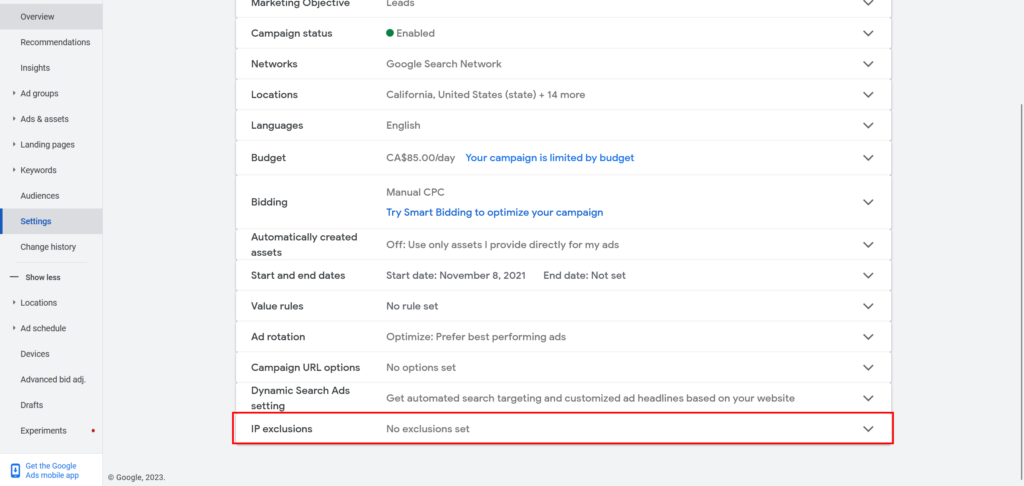
Automations
You can use automations like automated rules or Google Ads scripts to automate various tasks within your Google Ads campaigns, like adjusting bids, managing keywords and Ad text, etc. If you’re using any such automation, verify they are working as expected, if not then make necessary adjustments or suspend the automations altogether and manage your account & campaigns manually.
Why a Google Ads audit is like a personal trainer for your campaigns
A personal trainer helps you to reach your fitness goals. Similarly, a Google Ads audit helps you to reach your advertising goals. And, just like a personal trainer pushes you to do better and improve, a Google Ads audit pushes you to optimize and improve your campaigns.
A Google Ads audit is necessary because it:
- Identifies areas of weakness – like a personal trainer identifies that you have a weak spot for ice cream and Netflix, a Google Ads audit identifies areas of weakness in your campaigns. By identifying these areas, you can make adjustments and improve your performance.
- Helps you to stay on track – Your personal trainer keeps you accountable and makes sure you’re hitting your goals, a Google Ads audit helps you stay on track and reach your advertising goals.
- Keeps you updated – a Google Ads audit keeps you updated on the latest trends and best practices in online advertising.
- Sweats the small stuff – a Google Ads audit makes sure you’re sweating the small stuff (like your ad copy or keyword targeting).
So, if you want to reach your advertising goals and get the most out of your ad spend, consider a Google Ads audit as your personal trainer for your campaigns and make good use of it regularly.
How to Conduct Audits Regularly
Conducting regular audits for your Google Ads campaigns is crucial for their success. In the same way, regular check-ups are essential for maintaining good health, regular audits are essential for maintaining the health of your campaigns.
Here’s how to keep your campaigns in top shape:
Create a schedule – Plan out your audits just as you would plan out your doctor’s appointments. Whether it’s once a month or once a quarter, make sure you’re conducting audits regularly.
Set reminders – Set reminders for your audits in the same way you would set reminders for your doctor’s appointments. This way, you won’t forget to conduct an audit, and your campaigns will stay in top shape.
Get a second opinion – Just as a second opinion from another doctor can be helpful, having someone else conduct the audit with you can provide a fresh perspective and help identify issues you may have missed.
Don’t neglect the process – Don’t skip an audit, as you wouldn’t skip a doctor’s appointment. Even if you’re short on time, don’t neglect the health of your campaigns, otherwise they will result in wasted ad spend.
Embrace the process – Just as some people enjoy working out and some people don’t, some people enjoy conducting audits and some people don’t. But like working out is good for your body, conducting audits is good for your campaigns too. So, try to embrace the process and remember the benefits it brings.
By conducting audits regularly, you’ll be able to maintain the health of your campaigns and reach your advertising goals. So, schedule your next audit and keep your campaigns in top shape.
Tools that can help you in conducting the audit
Conducting a Google Ads audit can be a daunting task, but with the right tools, it can be a breeze. Like professional athlete uses advanced equipment to improve their performance, you can use advanced tools to improve your Google Ads campaigns.
Here are some tools that can assist you in conducting the audit:
Google Ads Editor – This tool is like your own personal assistant for your campaigns, allowing you to make bulk changes and keep track of your progress.
AdWords Performance Grader – a personal coach for your campaigns, analyzing your campaigns and providing you with a detailed report and suggestions for improvement.
SEMrush – Your own personal spy, providing you with valuable insights into your competitors’ campaigns and strategies.
Keyword Planner – Your Google Ads dictionary, helping you to find the right keywords to target for your campaigns.
By utilizing these tools, you can make the audit process much more efficient and effective. So, don’t be intimidated by the thought of conducting an audit, just call on the right tools for the job.
[Bonus] Common Mistakes Business Owners Make in Google Ads
Similar to how “Game of Thrones” fans make the mistake of trusting the wrong characters, business owners make mistakes in their Google Ads campaigns. And, regret their mistakes too.
Here are some common mistakes business owners make in Google Ads:
Not using negative keywords – Business owners usually ignore the importance of negative keywords. Not using negative keywords can lead to wasted ad spend and irrelevant traffic.
Not optimizing for mobile – Mobile friendliness is often overlooked by advertisers. Not optimizing for mobile can result in a poor user experience and lower conversions.
Not using ad extensions – Ad extensions help you capture the largest space on the search results page. Not utilizing ad extensions can result in lower click-through rates and lower conversions.
Not split testing – Do not stick to just one ad copy and creative. Always create multiple versions of your ads with significantly different ad copy or creative. Avoiding split testing can result in missing out on potential improvements and higher conversions.
That’s a wrap
Conducting a regular Google Ads audit is crucial for the success of your campaigns. By following the steps outlined in this guide, you can review your account structure, analyze your targeting, check your ad copy and creative, review your keywords and quality score, and analyze your campaign performance. Utilizing tools such as Google Ads Editor, AdWords Performance Grader, SEMrush, and Keyword Planner can also assist you in conducting the audit more efficiently.
Additionally, it is important to avoid common mistakes such as skipping negative keywords, not optimizing for mobile, missing on ad extensions, and ignoring A/B testing. By conducting regular audits, you can ensure that your campaigns are in top form and reach your advertising goals. Don’t wait until it’s too late, schedule your next audit today!

